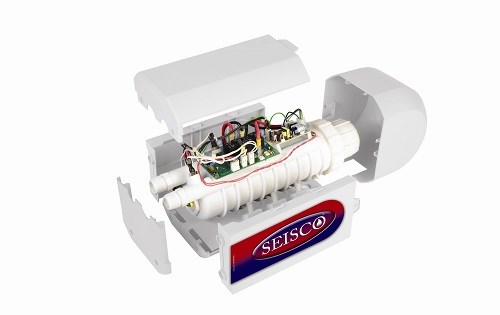Nylon, PBT Keys in Energy-Conserving Tankless Water Heaters
Seisco's next-generation residential tankless water heaters use DuPont's high heat resistant nylon and high impact resistant PBT.

The next-generation Supercharger tankless water heater units from Houston-based utilize engineering thermoplastics in several key components and have been designed to help homeowners meet the newly updated National Appliance Energy Conservation Act (NAECA) requirements.
Seisco’s president David Seitz says the new standards could drive up the cost and size of tank-type water heaters because efficiency technology will have to be added to the tanks that are 55-gal or larger. “A Seisco Supercharger coupled with a 40-gallon tank matches the performance of a 60 to 80 gallon tank with significantly lower energy use because you heat less water all day. Thousands of gallons of water are wasted each year waiting for hot water to travel through cold pipes. Heating at the use point can significantly reduce water waste and save energy.”
The Supercharger unit is small enough (15” x 7” x 6”) to be placed near the use point. It features an internal heating chamber, which is injection molded of DuPont’s Zytel nylon for high-heat resistance, thermal stability and compliance with NSF and UL requirements. DuPont’s Crastin PBT delivers impact resistance and compliance with UL flammability requirements in a one-piece protective exterior housing.
A microprocessor control manages on/off when flow starts/stops. The water heater’s patented mixing chamber provides a small amount of heated water and the patented “Power-Sharing” technology helps ensure elements heat evenly. These innovations are said to protect against scalding, scaling and sediment build-up. The single-chamber Seisco models can be used as a back-up for both new and existing hot-water storage tanks in single-family homes. Multifamily water heaters allow building owners eliminate storage tanks in each unit.
Want to find or compare materials data for different resins, grades, or suppliers? Check out Plastics Technology’s Plaspec Global materials database.
Related Content
-
Foam-Core Multilayer Blow Molding: How It’s Done
Learn here how to take advantage of new lightweighting and recycle utilization opportunities in consumer packaging, thanks to a collaboration of leaders in microcellular foaming and multilayer head design.
-
Get Color Changes Right In Extrusion Blow Molding
Follow these best practices to minimize loss of time, material and labor during color changes in molding containers from bottles to jerrycans. The authors explore what this means for each step of the process, from raw-material infeed to handling and reprocessing tails and trim.
-
For Extrusion and Injection-Blow Molders, Numerous Upgrades in Machines and Services
Uniloy is revising its machinery lines across the board and strengthening after-sales services in tooling maintenance, spare parts and tech service.







